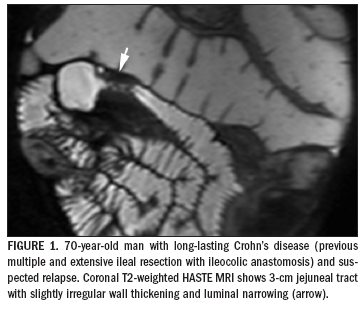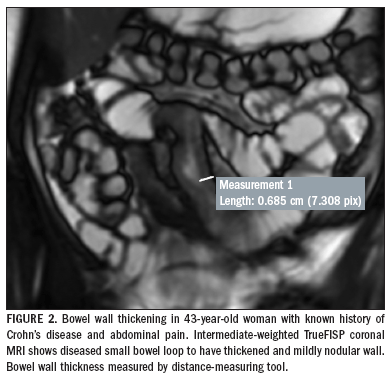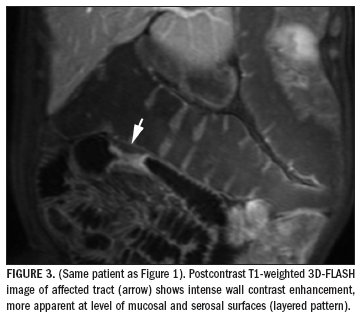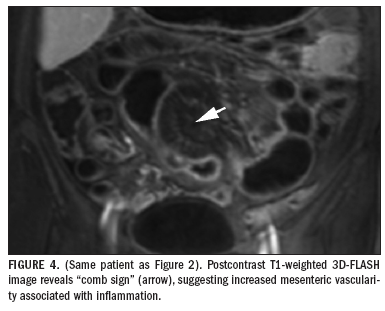MR imaging features combineto classify Crohn's disease
Crohn's disease is an inflammatory disorder ofthe gastrointestinal tract that is characterizedby multiform and, as yet, not well-establishedpathogenesis.
"Perhaps it is for all these reasons, as well as on account of the heterogeneity of Crohn's disease and the unpredictability of the human condition that our quest for the Holy Grail of one 'best measure of disease activity' still remains today, in Korelitz's words of 15 years ago, 'a need unfulfilled.'"1
Crohn's disease is an inflammatory disorder of the gastrointestinal tract that is characterized by multiform and, as yet, not well-established pathogenesis.2 It is a chronic condition and has a relapsing course. Initial assessment of inflammatory activity may help determine which patients will benefit from prompt and tailored treatment, and this is consequently of paramount importance.3 Further periodic assessments of inflammatory activity are crucial for monitoring the effects of drugs and for surgical therapy planning.4
Many instruments measuring disease-specific activity have been evaluated over the past 30 years. To date, however, no diagnostic technique has emerged as a standard reference tool for the reliable and reproducible quantification of inflammatory activity in Crohn's disease. Gastroenterologists typically make this evaluation on the basis of clinical symptoms, physical findings, laboratory parameters, endoscopy, and imaging tests.5,6
The Crohn's disease activity index (CDAI) is the most widely used clinical scoring tool for evaluations of inflammatory activity specific to Crohn's disease. The CDAI is used in everyday clinical practice and in most therapeutic trials, despite being based partially on subjective criteria that represent patients' perception of their disease rather than objective assessment.7,8

Biochemical markers, including white blood count, erythrocyte sedimentation rate, C-reactive protein, and orosomucoids, have been used as references for activity in imaging studies.4
The "scoring system for histologic abnormalities in Crohn's disease mucosal biopsy specimens” has been used to quantify the histological activity of the disease.9 This assessment is not generally recommended as a treatment end point due to the poorly investigated correlation between histological improvement and other assessments of disease activity. Other major drawbacks include the potential for sampling errors and inherent variability in biopsy techniques.8 Histology nonetheless shows a closer and less equivocal correlation with morphologic and postcontrast MRI findings than with clinical aspects.5,10
Barium examination, either by enteroclysis or followthrough technique, has traditionally been the gold standard tool for imaging the small bowel. Invasiveness, exposure to ionizing radiation, and the need for extensive bowel preparation, however, limit the use of this technique for the follow-up of disease.11 Conventional radiography is also unable to evaluate the activity and extension of the inflammatory process through and beyond intestinal mucosa.
Doppler ultrasound has proven useful in distinguishing between active and inactive disease, though no conclusions can be drawn from it about the severity of active disease.11 The role of CT in Crohn's disease has been firmly established, though exposure to ionizing radiation limits its widespread use. A correlation between disease activity and the degree of mural enhancement seen on CT has been demonstrated.12
Crohn's disease will last throughout a patient's lifetime. The disease manifests at a relatively young age in approximately 50% of cases. Optimal diagnostic workup requires that patients be monitored frequently. Monitoring techniques should consequently be noninvasive or minimally invasive and, above all, patient-friendly.

Although a perfect tool that meets all these requirements is not presently available, MRI has been advocated as one of the most promising techniques for small bowel imaging. The modality can provide an accurate assessment of disease activity, producing multiplanar images with high soft-tissue contrast. No ionizing radiation is involved, making long-term follow-up feasible, and the discomfort and risks are lower than with other methods.5,13 Disadvantages include the higher costs associated with MRI and the longer examination time, especially when compared with CT.4

Ultrafast MR sequences with breath-hold or respiratory triggering can provide high-quality panoramic images of the gastrointestinal tract and extraintestinal, intra-abdominal structures. The introduction of cine-MR mode has added valuable functional information on the motility of affected loops. This is despite the lower temporal resolution compared with conventional enteroclysis. 5,14 The impact of MRI on evaluations of Crohn's disease is consequently increasing, and imaging protocols, including small bowel distension techniques (enteroclysis versus followthrough) and MR sequences, have been standardized.3
MRI assessment of active disease has been shown to influence patient management significantly, regardless of the number of segments involved,15 as therapy is tailored toward individual patients rather than individual segments. MRI features of activity are consequently analyzed in most studies on a per-patient basis.
KEY MURAL MRI FINDINGS
Visualizing changes in the appearance of the bowel wall helps confirm the presence and phase of disease.
• Bowel wall thickness. Bowel wall thickness has been widely tested as a way of discriminating between active and inactive Crohn's disease (Figure 1).15-19 One evaluation of therapy response in patients with active Crohn's disease found a substantial decrease of bowel wall thickness. Median values of wall thickness in the small bowel before and after treatment were 4.9 mm and 4.4 mm, respectively (p = 0.03).18 Researchers in a separate study concluded that on a per-patient basis, a bowel wall thickness of 4 mm or more has a sensitivity of 88% and a specificity of 75% for active Crohn's disease.15
Another group of investigators noted a significant difference in bowel wall thickness (p < 0.001) within affected bowel segments before and after remission (6.93 ± 3.02 mm versus 4.91 ± 2.31 mm, respectively). However, diseased segments remained pathologically thickened in both phases of disease compared with a control group of individuals with no Crohn's disease who underwent colonoscopy for other reasons (mean wall thickness = 3.37 ± 0.88 mm; p < 0.001). The authors attributed this to the fact that thickening is related to both an acute (edema) and a reversible (inflammation) component of the disease and a chronic component (fibrosis) that does not reverse.16 Other investigators have reported a statistically significant and good correlation (p = 0.0006; k = 0.786) between bowel wall thickness and disease activity.4
Bowel wall thickness is usually measured manually on monitor images using the workstation distance-measuring tool. Agreement has not yet been reached on the type of images that should be used for making these measurements. Some reports have measured bowel wall thickness on postcontrast T1-weighted images.15,16,18 Others do not mention the sequences used.4,14,17 Measurements have also been made on TrueFISP coronal and/or axial images (Figure 2).5
Reliable measurement of bowel wall thickness requires adequate luminal distension and a real cross-section of the affected loop. Some authors have suggested averaging multiple bowel wall thickness measurements of the same loop to avoid errors from potentially oblique-angled gauge distances (i.e., measurements not perfectly orthogonal to the real wall thickness).18
• Wall contrast enhancement. Enhancement of signal intensity in the bowel wall on T1-weighted images following administration of a gadolinium-based agent has been studied as an indicator of inflammation (Figure 3). The reason for this phenomenon is assumed to be an increase in capillary permeability, blood flow, and local tissue perfusion caused by vasodilatation and neovascularization that leads to an increased interstitial fluid uptake.13,17 Significantly higher wall contrast enhancement in segments of actively inflamed bowel compared with normal-appearing bowel loops has been reported (p < 0.01).15 Another study revealed a significant decrease in the mean value of wall contrast enhancement when patients with Crohn's disease changed from the active phase into clinical remission.16
Substantial agreement has been reached that wall contrast enhancement is probably the parameter most closely related to the degree of inflammation. Subjective categorical scales4,14,19 and quantitative methodology16 have been proposed to reliably quantify this finding. An investigation of postcontrast dynamic measurements, rather than simple enhancement on static images, has shown that both these kinds of MRI analyses can provide only a weak to moderate indication of the severity of Crohn's disease.17
• Layered enhancement pattern. A layered pattern of wall contrast enhancement has been observed in bowel segments with proven active disease, leading researchers to suggest that this finding is highly specific for active inflammation. 15 This appearance is thought to result from edema in the submucosal layer (where early inflammatory changes occur in Crohn's disease) and the muscolaris layer, which would lead to more apparent enhancement over the mucosal and serosal surfaces (Figure 3). The observation is supported by another study in which active disease presented as a layered pattern of wall contrast enhancement, and contrast uptake was homogeneous when the disease was inactive. Active disease was detected with high sensitivity (100%), specificity (87.5%), and accuracy (93.8%) on a perpatient basis.6
• Further mural findings. The presence of edema in inflamed bowel loops is represented by focal areas with high signal intensity on T2-weighted MRI. A significant correlation between active disease and marked wall hyperintensity has also been found.4,13 The identification of deep ulcers, a classic finding on conventional enteroclysis, has been shown to be the most sensitive MRI finding for Crohn's disease activity.14
EXTRAMURAL MRI FINDINGS
Information from beyond the small bowel wall can further refine assessment of Crohn's disease.

• Alteration of fibrofatty tissue. High T2 signal intensity has been reported at the level of fibrofatty tissue in cases of biologically active Crohn's disease.4 This feature is probably related to local mesenteritis, which leads to edema and dilatation of local vessels. An alternative explanation is that the fibrotic component of fibrofatty proliferation is seen as an area of low signal intensity on T2- weighted images, abnormally separating adjacent bowel loops.5,10 Although fibrofatty proliferation is observed frequently in patients with active Crohn's disease, three studies have rated its prevalence as low or having no statistical significance.14,15,20
• Vascularity of the mesentery. Increased mesenteric vascularity corresponds to the so-called comb sign. T1- weighted images demonstrate short, parallel, linear structures of low signal intensity precontrast or high signal intensity postcontrast close to the mesenteric border and perpendicular to the longitudinal axis of small bowel loops (Figure 4). Two separate studies found that although this feature is more frequently observed in patients with active Crohn's disease, the difference between active and inactive disease did not reach statistical significance.14,15 One explanation is that the comb sign has two different pathologic substrates in active disease and in Crohn's disease at remission, reflecting an expression of vasa recta dilatation and perivascular fibrotic changes respectively.14
• Further perienteric findings. Investigators have observed a homogeneous contrast enhancement (ranging from moderate to intense) in the mesenteric lymph nodes of all patients with a CDAI greater than 150 (active Crohn's disease). This finding was also present in 50% of the patients whose CDAI was less than 150 (inactive Crohn's disease).14 Perienteric changes such as mesenteric lymphadenopathy, fistulas, and abscesses are specific but infrequent among patients with active disease.15
Bowel wall thickness and wall contrast enhancement are the features of Crohn's disease on MRI that have been investigated the most and shown to be most reliable. Some authors have attempted to arrange sparse MRI findings into scoring systems capable of providing an overall interpretation.5,14,19 Their results suggest that overall assessment of disease activity needs to be based on integrated rather than a few single findings.
The Reading Room Podcast: Current Perspectives on the Updated Appropriate Use Criteria for Brain PET
March 18th 2025In a new podcast, Satoshi Minoshima, M.D., Ph.D., and James Williams, Ph.D., share their insights on the recently updated appropriate use criteria for amyloid PET and tau PET in patients with mild cognitive impairment.
Study with CT Data Suggests Women with PE Have More Than Triple the One-Year Mortality Rate than Men
April 3rd 2025After a multivariable assessment including age and comorbidities, women with pulmonary embolism (PE) had a 48 percent higher risk of one-year mortality than men with PE, according to a new study involving over 33,000 patients.